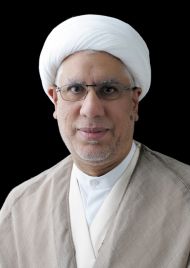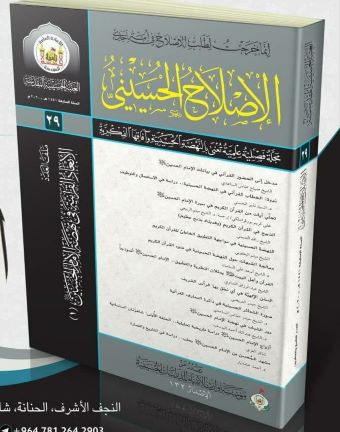
 علاف مجلة الإصلاح الحسيني ، العدد 29، السنة الثامنة، 1441هـ - 2020م
|
نشرت مجلة «الإصلاح الحسيني» وهي «مجلة فصلية علمية تعنى بالنهضة الحسينية وآفاقها الفكرية، وتصدر عن مؤسسة وارث الأنبياء للدراسات الحسينية التابع للعتبة الحسينية المقدسة في النجف الأشرف» في عددها الجديد التاسع والعشرين، السنة الثامنة 1441هـ - 2020م دراسة علمية لسماحة الشيخ الدكتور عبدالله أحمد اليوسف بعنوان: «دور الشباب في نهضة الإمام الحسين  ».
».
وقد جاء في مقدمة الدراسة ما نصه:
تمتاز مرحلة الشباب بالقوة والحيوية والحماس والنشاط والفاعلية، فأيام الشباب هي مرحلة القوة بين ضعفين: ضعف الطفولة، وضعف الشيخوخة، وقد أشار القرآن الكريم إلى هذه الحقيقة بقوله تعالى: ﴿اللَّهُ الَّذِي خَلَقَكُم مِّن ضَعْفٍ ثُمَّ جَعَلَ مِن بَعْدِ ضَعْفٍ قُوَّةً ثُمَّ جَعَلَ مِن بَعْدِ قُوَّةٍ ضَعْفًا وَشَيْبَةً يَخْلُقُ مَا يَشَاء وَهُوَ الْعَلِيمُ الْقَدِيرُ﴾ ، فمرحلة الطفولة هي مرحلة ضعف واعتماد على الأبوين، ومرحلة الشيخوخة كذاك مرحلة ضعف وعجز عن تحمل المسؤوليات الكبيرة، وخصوصاً فيما يتطلب قوة بدنية كالقتال والحرب.
والشباب بما يملكون من طاقات ومواهب وإمكانيات، وبما يتميزون به من قدرات عقلية وبدنية، وبما يتصفون به من سمات نفسية وأخلاقية قادرون على صناعة التغيير الاجتماعي، وإحداث الكثير من المتغيرات فيما يجري من حولهم، لذلك نلاحظ أن كل الذين يصنعون التغيير في مختلف المجتمعات الإنسانية هم شريحة الشباب، فهم -عادة- من يحملون راية التغيير، ويرفعون شعار الإصلاح.
وقد اشترك في النهضة الحسينية المباركة الشباب والشيوخ، والكبار والصغار، والرجال والنساء، والأحرار والعبيد، والعرب والعجم، فقد كان أنصار الإمام الحسين  من قوميات وبلدان متعددة، ومن مراحل عمرية مختلفة، ولكن الفئة الغالبة كانت من شريحة الشباب؛ فمنهم من لم يبلغ الحلم كالقاسم بن الحسن، ومنهم من كان في ريعان شبابه كعلي الأكبر، وعبد الله بن مسلم بن عقيل.
من قوميات وبلدان متعددة، ومن مراحل عمرية مختلفة، ولكن الفئة الغالبة كانت من شريحة الشباب؛ فمنهم من لم يبلغ الحلم كالقاسم بن الحسن، ومنهم من كان في ريعان شبابه كعلي الأكبر، وعبد الله بن مسلم بن عقيل.
ووفقاً لما تشير إليه المصادر التاريخية عن أعمار الثوار والأنصار الذين استشهدوا مع الإمام الحسين  في كربلاء، فإن فئة الشباب كانوا العنصر الغالب في تركيبة الجيش الحسيني، وأنصار الإمام الحسين
في كربلاء، فإن فئة الشباب كانوا العنصر الغالب في تركيبة الجيش الحسيني، وأنصار الإمام الحسين  وأصحابه.
وأصحابه.
ومن الطبيعي أن يكون الشباب هم العنصر الغالب في النهضة الحسينية، لأن شريحة الشباب من أكثر الشرائح الاجتماعية تأثيراً وتأثراً، وأكثرها حماساً واندفاعاً، فهي كفئة عمرية تكون في عنفوان عطائها وحيويتها، وفي أوج قوتها وقدرتها، وتستطيع أن تقاتل وتحارب، ولذا نجد أن الجيوش في الدول إنما تتكون في أغلبها من الشباب.
وقد كان للشباب المؤمن دور مهم وفاعل ومؤثر في معركة كربلاء، حيث أبلى الشباب فيها بلاءً حسناً، وجاهدوا جهاد الأبطال مع الإمام الحسين  ، ونازلوا الأعداء ببسالة وشجاعة عزّ نظيرها.
، ونازلوا الأعداء ببسالة وشجاعة عزّ نظيرها.
وتتناول هذا الدراسة «دور الشباب في نهضة الإمام الحسين  »، ودورهم الفاعل فيها، وقد اشتمل على أربعة مباحث رئيسة، وهي:
»، ودورهم الفاعل فيها، وقد اشتمل على أربعة مباحث رئيسة، وهي:
المبحث الأول: مفهوم الشباب.
المبحث الثاني: اهتمام الإمام الحسين  بالشباب.
بالشباب.
المبحث الثالث: نماذج من شباب كربلاء.
المبحث الرابع: واجبات الشباب اليوم.
وكان نهاية المطاف (الخاتمة) التي اشتملت على استخلاص أهم النتائج المستوحاة من خلال البحث.
ملاحظة: يمكنكم قراءة كامل الدراسة من خلال الرجوع إلى المجلة المذكورة.
وهذا ملخص الدراسة باللغة الإنكليزية
Research Abstract
This research titled “ The Place of youths in Imam Al-Hussain’s Renaissance” discusses the role of youth in Imam Al-Hussain’s renaissance and their effective and influencing participation in the Battle of Karbala. The Hussaini army was mostly consisting of youths. Youth segment is normally distinguished by vigor, activity, vitality, strength, and health. Hence, it has the best potential to engage in wars, encounter enemies and defy dangers.
The beginning of the research is mainly concentrating on manifesting the importance of youth, as it is the most essential social segment for the course of social movement. Young people are a vital element of changing and influencing in human communities. Therefore, we find that all reformers and leaders give attention to the youth and work on attracting and assimilating them. Young people are an influencing element in changing the course of events in different aspects of life. Consequently, one who reaches out to young people reaches power to achieve his goals and purposes regardless of being right or wrong.
The importance of youth goes back to the characteristics this stage is marked by such as health and well-being, work and activity at the peak, and ability to take serious responsibilities, which are explicitly discussed in the research.
Afterwards, the research reviews the most important characteristics of religious youth. Religious emotions are profoundly expressed when one approaches the stage of youth. This is displayed through youth’s passion to religion and through seeking a better understanding of religious issues and showing positive interaction with all that represents religious intellect and through being distinguished by religious enthusiasm. Such enthusiasm is affected by youth interactive character and it takes different forms of signs and manifestations. It may also be shown socially or solitary.
Reformers and scholars take a great responsibility of educating, guiding and directing the youth towards the values, teachings and commandments of Islam. In addition to enhancing the youth’s authentic religious awareness, as well as making use of their mental readiness and spiritual willingness by encouraging them to seek more knowledge, work and giving that serve the community, the nation and the human civilization.
After that, the research highlights the attention and care given by Imam Al-Hussain (PBUH) to the youth. Imam Al-Hussain (PBUH) used to check their social conditions and ask about their interests. Imam Al-Hussain (PBUH) gave them an exceptional care for the importance of their role in any social change.
Following that, the research mentions examples of Karbala youths. Most of Imam Al-Hussain’s supporters were young. When we take a look at the names and ages of the martyrs, we find that they were young believers.
The research is finally concluded with an indication to the responsibilities of youth in today’s time and all times, starting from the lessons of Hussaini renaissance and the sacrifices of Karbala youths, which are as the following: boosting the system of values and ethics, demonstrating the ethics of Imam Al-Hussain (PBUH) and following his significant example, taking responsibility of their selves and their society and seeking knowledge and excellence; knowledge is the power of present and future.





